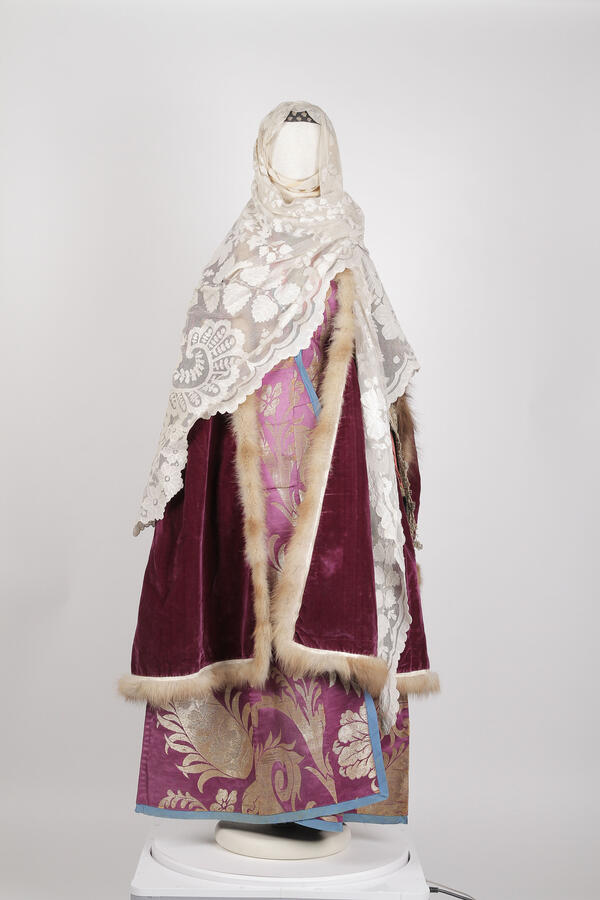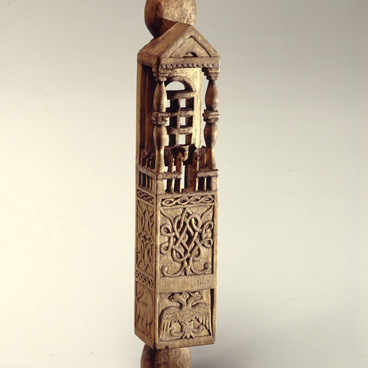Jewish girls got married as young as 10-13 years old, and matchmaking began when they were between 6 and 8 years old. At the same time, they began to prepare a dowry. For every holiday, the bride-to-be was sent gifts from the groom’s home. Among them were some lengths of fabric from which clothes for the dowry were sewn. Common people used canvas, linen, sateen and cloth, while wealthy people had satin, silk, velvet and fur. A set of wedding clothes was presented to the bride by the groom’s parents. Rich brides could have several such sets, which they wore during the first days after the wedding.
A katibi — the bride’s outer garment — was worn unfastened. It was made of velvet of different colors, lined with fur or silk, cut at the waist, and decorated with small folds on the sides and back. A knee-length katibi had ornamental metal buttons sewn along the flaps. The sleeves were longer than the arms, and sometimes they were made false because they were rarely used. The katibi was usually thrown over the shoulders on top of a one-piece, full-length okro kaba — a golden dress. Georgian brides traditionally wore white, while Jewish brides wore colored dresses, often of light cherry colors.
A chikilya, or lechek — a large triangular scarf made of patterned tulle — complemented the festive attire of Georgian and Jewish women. Girls wore it over their hair braided into plaits, while married women used it as a headdress. A chikilya worn by Georgian women had the shape of an irregular triangle with a right angle. The sharpest angle was placed on the head, and the headscarf itself was wrapped under the chin so that the right angle fell on the back. Georgian Jewish women wore chikilyas in the form of an equilateral triangle with the ends hanging freely downwards.
Katibi, kaba and other items of clothing were part of the wedding dress and dowry of Georgian Jewish women. This kind of wedding attire was characteristic of Georgian women in eastern and central Georgia.
The bride’s attire from the collection of the Russian Museum of Ethnography belonged to an Akhaltsikhe Jewish woman from a wealthy family. The girl’s father owned a fabric store and provided his daughter with a rich dowry. Her wedding took place in 1883.
A katibi — the bride’s outer garment — was worn unfastened. It was made of velvet of different colors, lined with fur or silk, cut at the waist, and decorated with small folds on the sides and back. A knee-length katibi had ornamental metal buttons sewn along the flaps. The sleeves were longer than the arms, and sometimes they were made false because they were rarely used. The katibi was usually thrown over the shoulders on top of a one-piece, full-length okro kaba — a golden dress. Georgian brides traditionally wore white, while Jewish brides wore colored dresses, often of light cherry colors.
A chikilya, or lechek — a large triangular scarf made of patterned tulle — complemented the festive attire of Georgian and Jewish women. Girls wore it over their hair braided into plaits, while married women used it as a headdress. A chikilya worn by Georgian women had the shape of an irregular triangle with a right angle. The sharpest angle was placed on the head, and the headscarf itself was wrapped under the chin so that the right angle fell on the back. Georgian Jewish women wore chikilyas in the form of an equilateral triangle with the ends hanging freely downwards.
Katibi, kaba and other items of clothing were part of the wedding dress and dowry of Georgian Jewish women. This kind of wedding attire was characteristic of Georgian women in eastern and central Georgia.
The bride’s attire from the collection of the Russian Museum of Ethnography belonged to an Akhaltsikhe Jewish woman from a wealthy family. The girl’s father owned a fabric store and provided his daughter with a rich dowry. Her wedding took place in 1883.



